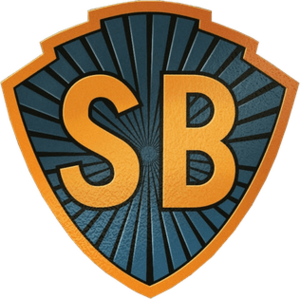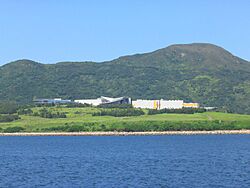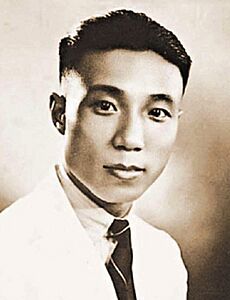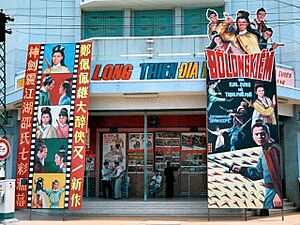Shaw Brothers Studio facts for kids

The Shaw Brothers logo was inspired by the Warner Bros. logo.
|
|
|
Native name
|
邵氏兄弟控股有限公司
|
|---|---|
|
Formerly
|
Shaw Brothers (HK) Ltd. (1958–2011) |
| Public company | |
| Traded as | SEHK: 953 |
| Industry | Film production Television production |
| Fate | Merged with another company to become Clear Water Bay Land Company Limited |
| Successor | Clear Water Bay Land Company Limited |
| Founded | 27 December 1958 |
| Defunct | 28 November 2011 |
| Headquarters | |
|
Area served
|
Worldwide |
| Products | Films Television shows |
| Subsidiaries | Shaw Brothers International Pictures |
| Shaw Brothers Studio | |||||||||||||||||
|---|---|---|---|---|---|---|---|---|---|---|---|---|---|---|---|---|---|

The newer Shaw Studios in Tseung Kwan O, Hong Kong.
|
|||||||||||||||||
| Chinese | 邵氏片場 | ||||||||||||||||
|
|||||||||||||||||
Shaw Brothers (HK) Limited was a famous film production company in Hong Kong. For many years, it was the largest movie studio in the country. The company operated from 1925 until 2011, creating nearly 1,000 movies.
It all started in 1925 when three brothers, Runje, Runme, and Runde, started a film company in Shanghai. Their youngest brother, Run Run Shaw, helped manage the business from Singapore. In 1958, they officially created the "Shaw Brothers" company in Hong Kong.
During the 1960s, Shaw Brothers built "Movietown," a huge movie studio that was one of the largest in the world. It was like a small city dedicated to making movies!
The company is best known for popularizing kung fu movies around the world. Some of its most famous films include The Love Eterne (1963), Come Drink with Me (1966), The One-Armed Swordsman (1967), The 36th Chamber of Shaolin (1978), and Five Deadly Venoms (1978).
In 1987, the company decided to focus more on making television shows through its other company, TVB. In 2011, Shaw Brothers was reorganized, but its name is still used today for producing TV shows.
Contents
The Story of Shaw Brothers
From Shanghai to Singapore
Before making movies, the Shaw brothers owned a theater in Shanghai. They saw how much people loved watching plays and decided to try filming one. Their first silent film was a big hit! This success led them to start their own film company in 1925, called Tianyi Film Company.
Soon, other movie studios in Shanghai tried to stop theaters from showing Tianyi's films. To solve this problem, the brothers decided to build their own network of movie theaters. Runme Shaw traveled to Singapore and started a business to show their movies all over Southeast Asia. By the 1970s, they owned over 200 cinemas.
In 1932, the studio made one of the first Chinese movies with sound, a Cantonese-language film called White Golden Dragon. It was so popular that they decided to open a studio in Hong Kong to make more Cantonese films.
Building a Movie Empire in Hong Kong
In the 1950s, the company began making more films in the Mandarin language. In 1957, Run Run Shaw moved to Hong Kong and started a new company, Shaw Brothers (Hong Kong) Ltd. He built a massive new studio at Clearwater Bay called Movietown, which opened in 1961.
Movietown was incredible. It had 15 different sets for filming, modern equipment, and over 1,300 employees. It was the biggest and best-equipped studio for Chinese films at the time.
The Golden Age of Kung Fu
The 1960s and 1970s were a golden age for Shaw Brothers. The studio became famous for its colorful historical dramas and exciting kung fu movies. Films like The One-Armed Swordsman were huge hits and broke box office records.
The studio made the kung fu genre famous worldwide with action-packed movies like Five Fingers of Death and The 36th Chamber of Shaolin. During this time, Shaw Brothers was in a friendly competition with another studio, Cathay Organisation, but Shaw Brothers eventually became more popular.
In the 1970s, a new studio called Golden Harvest became a major competitor. Golden Harvest had a lot of success with the martial arts star Bruce Lee. To keep up, Shaw Brothers started working with American and European companies to make films for a global audience.
A Shift to Television
By the mid-1980s, making movies became more challenging due to competition and video piracy. So, Shaw Brothers decided to stop making films for a while and focus on television. Their studio, Movietown, was renamed "TV City" and was used to produce popular TV shows for their channel, TVB.
A Lasting Legacy
The Stars of the Studio
Shaw Brothers operated like the old Hollywood studios. They signed hundreds of actors to contracts, meaning those actors could only work for them. This helped create many famous movie stars.
Famous Directors
The studio was known for its talented directors, who each had a unique style.
- King Hu was known for martial arts films that were like beautiful, action-filled ballets. His famous film Come Drink with Me starred a strong female hero.
- Chang Cheh was one of the most famous directors. He made exciting films about brotherhood, honor, and intense action. His movies include Five Deadly Venoms and One-Armed Swordsman.
- Lau Kar-leung started as a fight choreographer before becoming a director. He was a real martial arts master, and his films like The 36th Chamber of Shaolin are famous for showing authentic kung fu techniques.
Famous Actors
Many actors became huge stars thanks to Shaw Brothers.
- In the early days, actresses like Linda Lin Dai and Ivy Ling Po were famous for their roles in dramas and musicals. The musical The Love Eterne was so popular that some people watched it in theaters over 20 times!
- The Venom Mob was a group of five actors who starred in the 1978 hit Five Deadly Venoms and many other kung fu films together. Their names were Lo Mang, Lu Feng, Sun Chien, Chiang Sheng, and Kuo Chui.
- Ti Lung and David Chiang were a famous duo in the 1970s, often called the "Iron Triangle" along with director Chang Cheh. Ti Lung often played the strong, heroic character, while David Chiang played the clever anti-hero.
- Chen Kuan-Tai, early 1970s star in Chang Cheh's movies. He later stared as the lead actor in many other very popular Shaw movies. Chen Kuan-Tai, Ti Lung, David Chiang and Alexnder Fu-Sheng were known together as "The Fantastic Four" and "The Four Pillars Of Shaw Brothers" due to the impact their work had on the industry and for the success of the company.
- A fun fact is that a young Jackie Chan worked as an extra and stuntman in several Shaw Brothers films before he became a superstar.
- The studio also had many famous female action stars, including Cheng Pei-pei, who was known as the "Queen of Swords."
Inspiring Future Filmmakers
The movies made by Shaw Brothers had a huge impact on filmmakers all over the world.
- American director Quentin Tarantino is a big fan. He paid tribute to the studio by showing its logo in his movies Kill Bill: Volume 1 and Volume 2.
- The 2023 animated movie Teenage Mutant Ninja Turtles: Mutant Mayhem also gave a shout-out to Shaw Brothers. In the film, Master Splinter teaches the turtles martial arts by showing them clips from classic Shaw Brothers movies like The 36th Chamber of Shaolin.
What Happened to the Shaw Brothers Movies?
For a long time, many Shaw Brothers films were hard to find or only available as low-quality copies. Then, a company called Celestial Pictures bought the rights to the entire library of over 760 films.
Celestial Pictures carefully restored the movies, improving the picture and sound quality. They released them on DVD and streaming services, allowing a new generation of fans to discover these classic action films. Thanks to this effort, kung fu fans in the United States and around the world can now watch these masterpieces in high definition.
The Famous "Movietown" Studio
The original Shaw Studio, known as Movietown, was located at Clearwater Bay in Hong Kong. After the company stopped making movies there, it was used by the TV station TVB. Today, the old studio is empty but is considered a special historic site in Hong Kong because of its importance to film history.
A new, modern studio called Shaw Studios was built in another part of Hong Kong and opened in 2008.
See also
- Celestial's Shaw Brothers Film Library
- Golden Harvest
- Hong Kong action cinema
- List of Shaw Brothers films
- Shanghainese people in Hong Kong




